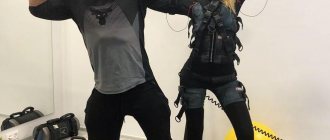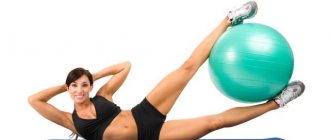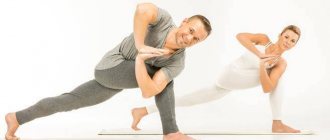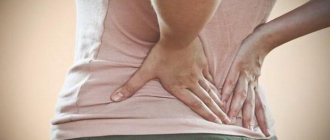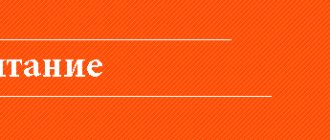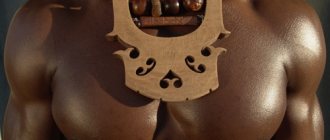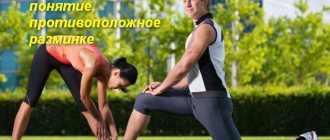Many girls who want to lose weight or gain muscle mass, when they come to the gym, do not understand at all what to do and how. The first thing they need is to create a lesson plan for themselves. Depending on their goals, girls can create a program for 1, 2, 3 or more workouts per week, with different numbers of repetitions per approach. How to correctly create a training program for a girl with a huge variety of exercises depends on her personal level of training and initial physical data.
Important! If you have musculoskeletal injuries, you should consult a sports doctor about acceptable and unacceptable exercises before starting exercise.
Essential microelements
To fully recover after a workout, the body needs protein more than ever. Its amount in food consumed after exercise should be approximately 60% of the total microelements. It's better if the remaining 40% comes from carbohydrates. Of course, you won’t be able to get rid of fats completely either, but their amount must be strictly controlled: their amount in food per day should not exceed 3 g.
What benefits do microelements bring:
- Protein is the main source of energy in the body. Thanks to it, the training muscles will be saturated with the amino acids necessary for their growth.
- Carbohydrates are glycogens. Such income will allow the muscular skeleton to be worked out more efficiently and will give a surge of new strength and energy to the training body.
- Fats are prohibited for consumption before training. Because otherwise, during physical activity, the girl will experience stomach discomfort. Also, eating fatty foods before the training process can cause nausea when the girl starts training.
https://youtu.be/lo-qlLzaHhY
What to eat after working out in the gym
Working out at the gym is guaranteed to change your body. Even if in the first months the kilograms do not go away as quickly as we would like. By building muscle on your body, a person increases your metabolism.
To maintain muscle tone, the body will need to spend twice as many calories as fat.
A toned body looks much slimmer than a thin one. People of the same mass, but with different physical fitness, are radically different in appearance.
To build muscle mass, you will need protein and complex carbohydrates. If your body is too thin and you need to build up your body, introduce more carbohydrates into your diet. If it is necessary to draw muscles through a layer of subcutaneous fat, you will need mainly protein.
So, in the gym you need to combine strength and cardio training. This can happen in one day. Then they do: cardio, then strength training and finish with cardio again. Or the second option is to distribute training over days.
What to eat after strength training?
Immediately after training, the first 30 minutes, the body perfectly absorbs proteins and carbohydrates.
This time is called the protein-carbohydrate window. It is acceptable to consume protein and fast carbohydrates. However, if the goal is fat burning, then focus on proteins. Another option is to drink a protein shake.
If the workout was done in the morning, you can eat fruit or something protein.
If training is carried out in the afternoon, egg white is allowed (quickly digested). But cottage cheese is not suitable, it is processed too slowly.
Two hours after exercise, you need to eat proteins and carbohydrates again. The general evening meal plan after strength training for weight loss excludes starchy carbohydrates. You will need proteins and fiber.
It is advisable to exclude confectionery products during the period of weight loss.
What to eat after cardio training?
The main fat burning occurs directly during the workout itself.
Therefore, after the first half hour of training, the body should be allowed to continue destroying subcutaneous fat reserves. Then be sure to eat to stop the catabolic process in which the body burns muscle mass.
The first meal after training allows:
- protein;
- yogurt;
- cottage cheese.
If you don’t have food on hand, you can replace it with a protein shake. The second dose after another 1.5 hours should include slow carbohydrates.
It doesn't hurt to add fresh vegetable salads. Allowed: radishes, greens, cabbage, cucumbers, tomatoes. It is advisable to season such salads with olive or linseed oil.
Complex 4
Training in the summer of the first year of classes was more of a supportive nature, a kind of rest after the “impact” loads of the spring. Another goal of this complex was to strengthen the ligaments and tendons in order to prepare them for a new “spurt” in the development of strength and “mass”, which was supposed to start in the fall. These goals were achieved, again, by changing the nature of the loads: the number of repetitions increased and the rest pauses between approaches shortened. After a “lazy” spring training, this gave a good “shake-up” to the body.
Mon., Wed., Fri.
- Wide-grip chest-to-chest pull-ups, 50 reps.
- Bent-over barbell row, 1×12*, 4×10.
- Bench press on an incline (45°) bench, 1x12*, 4x10.
- Dips, 15*, 4×12 with weights.
- Squat, 1x20*, 4x15.
- Seated dumbbell press in an overhead arc, palm-inward grip, 1×12*, 4×10.
- Biceps with dumbbells standing alternately, 1x12*, 4x10.
- Straight leg raises on parallel bars or hanging, 50-100 repetitions.
Although the complex is supportive in nature, you should still strive to increase working weights. At the same time, some aerobic activity is desirable during this period - swimming and slow running. The heart should be prepared for the load that accompanies a fairly large gain in body weight in the second year of training.
PS I guarantee that while reading the chapter on first-year training, the interested reader has already had several questions. I will try to anticipate the most obvious ones.
Video How to do stretching for men and girls at home after training
https://youtu.be/aSJ19FBjjL8
According to Hinduism, the body and mind are one, so the path to divine enlightenment is through equally important mental and physical exercises.
Yogis paid no less attention to the development of the body than to the cultivation of the mystical properties of consciousness. One can argue with the philosophy of yogis, but the main concept of Hinduism is confirmed by modern science: a high, healthy spirit lives only in a healthy body.
Yoga poses amaze with their gymnastic complexity, but the main condition for preparedness is not physical strength, but amazing flexibility. Yogis gave this property of the body a truly divine meaning.
Oddly enough, materialistically minded scientists who undertook to study the effect of flexibility on human health were faced with a number of inexplicable phenomena.
In particular, it turned out that the development of flexibility in mature people causes a distinct effect of rejuvenation! Regular flexibility training improves the body's hormonal levels, increases intelligence and... potency!
When and why to stretch muscles in the gym
Stretching exercises have a powerful relaxation effect for girls and men, so you should not stretch before strength training. (If only a little bit.)
The time to stretch is after your workout. This is where 10 minutes of thoughtful and competent stretching movements are enough to reduce recovery time by 15-25%!
However, something else is much more important for a bodybuilder. Strength exercises strengthen joints over time. If you were a powerlifter, this would be considered a positive thing. The connective tissue coarsens, becomes thicker and thereby strengthens the joints.
However, in bodybuilding the opposite is true; loss of flexibility reduces the range of exercises.
And this prevents your muscles from growing!
According to the latest scientific concept, the growth of muscle volume is dictated by simple physical stretching of the membranes of muscle fibers.
These shells have a large supply of elasticity. Under the influence of repeated repetitions pumping blood into the working muscle, each fiber thickens, stretching its outer shell. Then the blood drains, and the elastic corset of the shell contracts, returning the fiber to its previous volume.
As you know, water wears away stones. Long-term training depletes the elasticity of the connective membranes of the fibers, and they begin to gradually stretch. As a result, the fibers become thicker and thicker, like a bicycle wheel under the influence of a pump.
What happens is what is called an increase in muscle volume. If the process is not supported by regular pumping, the muscles turn into a punctured tire.
Since we are talking about microscopic scales, it takes years to stretch the shells. For example, the path to becoming a pro takes about 10 years.
Now listen! It turns out that the biological mechanism that compresses the diameter of the fibers can be interfered with! To do this, you just need to strongly stretch the working muscle!
Think for yourself, previously the elasticity mechanism resisted only the transverse expansion of the fibers, but now it will also be forced to resist longitudinal stretching. This means that the compression forces will weaken significantly!
In short, to one type of stretching you add another. It is clear that progress will go faster this way.
Regularly practice stretching for girls and for men working muscles after training for girls and for men (and even between sets), and you will get a real acceleration in the growth of muscle volumes!
How to build your workouts and nutrition according to your body type
A-shaped
The shoulders are narrow, the pelvis is slightly wider; impression of a “heavy” lower body - full legs and buttocks; tendency to store fat below the waist (the upper body may even appear thin); low metabolic rate (if you don’t specifically follow your diet, weight gains quickly).
The damned "breeches" are not as invincible as they seem at first glance! Fitness training will help you make your thighs exactly what you dreamed of! The general recommendations are as follows. Your figure needs so-called heavy complex exercises (several exercises are included in the work), developing several “leg” muscle groups at once. And this will ultimately fundamentally change the appearance of everything below your belt. The lower body exercises listed above require high to moderate reps.
You should seriously work on the top as well. For what? To shift the visual emphasis away from heavy hips. (After all, your frail shoulder girdle usually unfavorably emphasizes this heaviness.) There is one “trick” here. You need to add muscle to your upper body by training with heavier weights and fewer repetitions. But don't be afraid: you won't become a weightlifter in a skirt!
Remember: the more you do aerobics, the faster you will lose weight! But do not forget about the measure - 1-2 days off.
Nutrition Guidelines: Most carbohydrates should be consumed before evening.
T-shaped
The shoulders are wide, wider than the pelvis; fat is deposited mainly on the torso (back, chest, sides); average metabolic rate (you only gain weight if you start eating too much).
If you have narrow hips and thin legs, and a much larger upper body, then you are a T-type. In order to balance the upper and lower body, you need to lighten the top and add more to the lower body. As a way to reduce the upper body, you can use the “superset” technique. A superset is two exercises for the same muscle group, performed one after the other. And for the bottom, on the contrary - complex exercises with a small number of repetitions and heavy weight.
Here nutritionists propose the reverse principle of nutrition to type A - carbohydrates in the evening.
Do aerobics 4-5 times a week.
X-shaped
The bones are medium; The width of the shoulders is approximately equal to the width of the hips; slim waist; full breasts; fat deposits form on the buttocks and thighs; average metabolic rate (you only gain weight if you start eating too much).
The X type is considered the classic female figure. The bottom and top are proportional, between them there is a narrow isthmus of the waist. The proportions of your figure are close to perfection. And yet, there is no need to relax; poor nutrition and exercise, as well as age, can ruin your figure. Already at the age of 20, muscles begin to lose their elasticity. And after 30, other factors also have an impact: hormonal changes, having children, etc. In order to maintain your figure, you need to eat wisely and do exercise.
Your main goal is to strengthen your muscles, thereby maintaining your unique hourglass physique. To do this, you will have to train 3 times a week, every other day. If you want to lose weight, it is better for you to rest no more than 30 seconds between approaches; approaches can be increased by 1-2 from the prescribed one. In any case, vary the intensity of the load! In other words, try to vary the number of repetitions and the weight of the weights from workout to workout.
Read also: Book Losing Weight with Ksenia Borodina.
Do aerobics 4-5 times a week.
H-shaped
Wide or medium boned; small breasts; full legs; visual impression of approximately the same width of shoulders, waist and pelvis; tendency to form fat deposits in the abdomen and thighs; moderate metabolic rate.
You are lucky: you naturally have a strong, muscular body. As far as the lines of the figure are concerned, your top and bottom are more or less balanced. There is only one problem - a protruding belly and a wide waist. With such a flaw, your figure can hardly be called ideal. At the same time, you are closer to the ideal than other types of women. I'll explain why. Your muscles, which are naturally strong, respond very quickly to formative exercises with weights. This means that it is much easier for you than for everyone else to give your body a truly perfect look.
So, your first goal is to lose fat around your waist and strengthen your abdominal muscles. Many people believe that the way to get rid of fat in the waist area is simple - every day, they say, you need to “pump up” your abs until you drop. However, this is an amateurish approach. By “pumping up” your abs, you strengthen your muscles and that’s all. Exercises here, unfortunately, will not help. How to be? The optimal solution is to hit your waistline with a combination of a low-fat diet, aerobics and a training program that targets your abdominal muscles.
Which diet is better? Remember, we are not talking about total restrictions! If you decide to eat very little, you will only harm yourself. Dieting will weaken your body, and you will not be able to develop the level of intensity of athletic effort that leads to success. In fact, how can you “swing” for hours and do a lot of aerobics every day if you are on a meager diet? What is needed? Start by eliminating fatty foods. Less oil, fried, stewed and any other dishes soaked in fat. Less mayonnaise, cheeses and sausages. If it's meat, then it's boiled. If vegetables, then boiled or stewed in water.
Why start with fats? The fact is that they play a major role in our obesity. The more fats you eat, the more they will be deposited under the skin. The second most harmful foods for you are sweets. In response to sweets, the body releases the hormone insulin. It stimulates the susceptibility of fat cells to dietary fats. Figuratively speaking, they “open” to fat and easily absorb it. In this sense, confectionery products are doubly dangerous. They contain both sugar and fat. It is clear that you need to give up pastries and cakes first of all. But there are also hidden dangers. For example, soft drinks, the same Coca-Cola. One glass contains 6 tablespoons of sugar! If this diet does not help, move on - limit your consumption of bread, pasta and noodles. Instead, eat more vegetables, potatoes and cereals. This will definitely work!
And further. Remember: you can’t either “go on” a diet or quit it. As a result of this “pendulum” you will get a waist like a hippopotamus. The mechanism here is like this. First, you lose a few kilograms with the help of a diet. Then you return to your normal diet and gain them again. But already with a small surplus! Moreover, as experience shows, new fat is deposited around the waist. You already know the reason: the fat cells at the waist are the largest and most “fat-intensive.”
Read also: Hand and foot care
I-shape
Thin bones; gauntness; weak muscles; almost no fat deposits; high metabolic rate (no matter how much you eat, you don’t get fat). In comparison with their overweight friends, thin women indeed look more attractive, but they always lose next to those who are endowed with seductive feminine forms. How to be? Add some curves to your figure! This will not only improve your appearance in itself, but will also have a positive effect on your health. Thin women have a very low proportion of muscles in their total body weight, and this is somehow related to reduced immunity. In any case, “pumped up” skinny women completely stop getting sick.
In order to get curves, of course, you will have to gain a little weight. And here you need to carefully monitor that new kilograms are added due to spectacular, attractive muscles, and not fat. To do this, you need to combine a well-thought-out training program with dietary recommendations.
Principles of fitness training for an I-shaped figure Here are rules that you must follow exactly like a pharmacy prescription! They relate to the general training methodology: intensity of loads, number of repetitions of exercises, duration of rest between sets and regularity of exercises.
Intensity To add elegant roundness to your body shape, you need to work with a lot of weight. Vary the intensity of the load! In other words, try to vary (within the limits indicated below) the number of repetitions and the weight of the weights from workout to workout.
Low reps Your growth pattern is heavy weights but relatively low reps. It is fundamentally! Sports science has clearly established that for anabolism (muscle tissue growth) you need to do 6 to 10 repetitions per set, with heavy weights.
Rest longerThe length of rest between sets depends on your body type and goals. If the goal is to burn fat, the breaks should be short. But you don’t have excess fat! And your metabolism is already fast, so you burn a lot of calories without any effort. So, you need to rest longer between sets - one or two minutes. Exactly what you need! After all, you are working with heavy weights, and you can’t overcome heavy weights unless you take a thorough rest first. However, try to keep your rest periods approximately equal in length. By resting for one or three minutes, you will psychologically lose your workout rhythm.
Regularity of training For those with an I-shaped figure, it is best to exercise three times a week, with one or two days of rest breaks (depending on your mood). Don't try to exercise every day. This will lead to the opposite effect - the muscles will shrink. The explanation is that training only “triggers” certain growth mechanisms in the muscles. The growth itself occurs between days of training. If you give your muscles physical activity at this time, you will thereby interfere with muscle growth. I repeat: the optimal training regimen for you is 3 days a week. However, if you're overexerting yourself at work or at home, add another day of rest before your next workout.
O-shaped
Wide bones; wide pelvis and shoulders; full hips, chest, arms; obvious excess fat deposits throughout the body; low metabolism (weight comes on even if you eat relatively little).
For those with an O-shaped figure, the main goal is to lose excess fat. But very often, the struggle with extra pounds is reminiscent of trying to ride up a hill on roller skates: a lot of effort, but there is no result! The reason is that fasting is usually considered the first remedy. There is no doubt that strict diets can help you lose weight, but for how long? The hated kilograms usually come back with the inexorability of the sea tide. How to find a way out of the tunic? The answer is: you need to take up sports!
Read also: Stevia: an easy way to lose weight without giving up sweets
Let me remind you of the law of weight loss: you must burn more calories than you take in from food. A state of energy deficiency will force your body to turn to an “alternative” source of energy - subcutaneous fat. This is actually why nature stores fat under our skin. Fat always “falls off” during fasting, but you won’t be able to gain a good figure through fasting alone. The fact is that a long-term lack of food calories sooner or later forces our body to “hibernate” in order to save its own resources. All physiological metabolic processes slow down, including the “burning” of subcutaneous fat. Not only does the weight stabilize again, but the most problematic areas of fat accumulation remain completely untouched - in the hips, buttocks and abdomen. If you take up sports, then “hibernation” will not threaten you. Physical exercise from workout to workout boosts your metabolism - what kind of hibernation is that! Moreover, sports enhances fat metabolism, which means that you will lose weight more effectively. In short, with sports, your efforts to transform your figure will undoubtedly end in triumphant success! The main thing is to train correctly!
Safety precautions for an O-shaped figure Many owners of an O-shaped figure have either never trained at all or have been involved in sports in the distant past. Therefore, the load must be increased very carefully and gradually. Pay special attention to my advice:
- If you have never given your body a real workout before, first make your daily life more active: walk more, take the stairs instead of the elevator.
- After several weeks of such “activation”, you can start fitness training. At first, work only with light to moderate weights. This will help launch the fat burning mechanism. Gradually increase the load, adding 1-2 kg per week.
- Do aerobic exercise at least three times a week for 20-30 minutes. The pace of the class should be such that you can talk. This will keep your heart rate at 60 to 80 percent of your maximum—enough to burn 1,500 to 2,000 calories a week.
- Try to increase the duration and frequency of aerobic exercise, eventually bringing it to 45 minutes four to five times a week.
- Don't skip training!
The best types of aerobics for an O-shaped figure
To achieve permanent weight loss, it is better to engage in aerobic exercise, which forces the whole body, or at least large muscle groups, to work. Walking is one of the easiest and at the same time effective types of aerobics. The main thing is to walk as long as possible. Fat burning begins only after the duration of exercise has exceeded 20 minutes. Swimming is often recommended for very overweight people - it is absolutely safe for the joints.
Most of the tips for eating O and H types apply to others when training for fat loss.
I would like to add that “pure” species are extremely rare, mostly mixed.
Recommended products and food blacklist
Post-workout nutrition for weight loss for women should start with eating the right foods. For 30 minutes after the end of the workout, the body is open to the effects of the so-called anabolic window. This means that the food that enters the body in a given time period (except for fat-containing food) will be completely absorbed and will contribute to the restoration of muscle mass after active training. It will not be stored in fat reserves. But of course, its quantity, for proper distribution by the body, must be limited - 400-500 kcal is enough.
After training you can and should consume:
- cranberry juice;
- grape juice;
- rice;
- durum pasta;
- vegetables;
- whole wheat bread;
- bread;
- omelette;
- protein bar;
- a small amount of cheese.
It is also recommended to include protein drinks in your post-workout diet. Their use will help accelerate protein synthesis in the body several times. When preparing a protein shake, you need to expect that for every kilogram of ideal weight there should be no more than 0.55 g of protein powder. These cocktails can be replaced by eating foods rich in protein. This includes: turkey meat, seafood, pink salmon, chum salmon, tuna, legumes.
If you want to lose weight, give up foods such as sugar, be careful with dairy products (buy only low-fat), do not eat beef and pork - replace them with veal. Also, don't eat fried foods. It is better to replace such food with steamed or boiled food.
Divide your meals into 5-6 meals a day, but eat small portions so as not to stretch your stomach. You also shouldn’t overeat before going to bed - it’s better that after dinner at least 3 hours pass before bedtime.
In order to maintain accelerated metabolic processes in the body after an intense workout, which contribute to rapid weight loss, it is enough to follow all the above recommendations, including eating right.
1. Body type – Curvy
The owners of this figure have strong muscles, an abdominal region with well-developed internal organs and wide bones. Such girls do not have a narrow waist, and smoothly, gracefully flowing shapes. Problem areas are the thighs (breeches), buttocks and lower abdomen.
For them, achieving an ideal abdominal plane is an insoluble problem, but it is possible to remove fat folds.
In this case, sharp, explosive movements are suitable, but before this the body needs to be well prepared - cycle aerobics, interval training and other types of aerobics where you need to do a lot of movements can help.
After that, you are ready for the gym, where working on machines, free weights, doing pull-ups and push-ups is just right for you.
Measured running is not suitable for such a figure; it is better to use alternating sharp running with a transition to a smooth one and then alternating it further, this will allow you to burn more calories.
A set of exercises for children 3 months old
1. Hand massage. We start with stroking, then add rubbing, and end with shaking. Don't forget about massaging your palms and fingers. There are many biologically active points on the palms, massage of which stimulates the functioning of internal organs, and massage of the fingers promotes the development of the child’s fine motor skills and, as a result, his speech and mental development.
2. Crossing your arms over your chest. Take the baby by the arms, spread them to the sides and perform the spread and contraction of the arms on the chest in a cross shape, alternating between the left and the right hand on top. If the child’s arm flexor muscle tone has not improved by this time, then you may not be able to perform such an exercise, then spend more time on massaging movements.
3. Massage the abdomen clockwise in a circle, then exercises for the prevention and treatment of umbilical hernia (same as in 1-2 months).
4. Exercises for the abdominal muscles, as well as for the prevention of colic and constipation. Bend your knees and press them towards your stomach. Raising straight legs to the head, lifting each leg alternately to the opposite ear, i.e. We touch the toes of the right foot to the left ear and the toes of the right foot to the left ear, respectively.
5. Extending the legs bent at the knees to the sides, you can perform circular movements in the hip joints.
6. Foot massage. Stroke and rub the baby's legs from the heel to the groin area
Pay special attention to massaging your baby’s feet and mobility in the hip and ankle joints. On the feet, as well as on the palms, there are many biologically active points, the stimulation of which will strengthen the baby’s body
7. Back massage. Start by stroking from bottom to top with the backs of your hands, from top to bottom with your palms, then rub the back on both sides of the spine from the butt to the neck, don’t forget to knead the baby’s buttocks. Then turn the baby onto its side and perform a reflex exercise - flexion and extension of the spine.
8. Teach your baby to roll over onto his tummy from a position on his side; when he masters this rollover, teach him to roll over from a position lying on his back. To do this, bend your knee and turn your baby’s leg in the direction of rotation and lead him by the hand in the same direction.
9. Extension of the spine while lying on the stomach in a canopy - “airplane”. Take the baby under the tummy with one hand, hold the baby’s feet with the other and lift him in this position, the baby will raise his head and bend his back.
10. Take the baby under the armpits and rest his feet on the table, the baby will push off from the hard surface with them, as if dancing.
11. Lifting by the handles. Place your thumbs in the baby's arms and, holding him by them, lift the baby, as if sitting him down. This exercise strengthens the neck muscles and teaches the child to hold his head when lifting. It is enough to perform up to 4-5 such lifts.
Complex 1 autumn
Three times a week every other day (Monday, Wednesday, Friday or Tuesday, Thursday, Saturday).
- Standing barbell cleans and chest presses.
- “Pulling” the barbell with a narrow grip to the chin.
- Bicep curls in a simple style.
- Squats with a barbell on your shoulders.
- Bench press.
- Bent-over barbell row.
- Bringing straight legs to the bar while hanging.
In the first complex, the dosage is standard for all exercises, with the exception of 7. The first approach is a warm-up, 12 repetitions with light weight, usually with an empty bar. Then 2-3 sets of 10 repetitions - enough to “feel” the working muscles. As for weights, the first complex is the only period of training when it was not recommended to “rush” with all your might, since the weights of the weights, as usually happens at the beginning of training, grow by themselves due to the improvement of the coordination connection between the brain and muscles. However, you shouldn’t forget that you should periodically treat yourself to an extra pancake on the barbell.
In exercise 7, it is recommended to perform 50 repetitions without taking into account the number of approaches, i.e. it can be 20, 15, 15 or 15, 15, 10, 10, or something else up to 10 sets of 5 repetitions.
If you are not yet 20-22 years old, then the first complex should be significantly modified. It is believed that at this age, with the help of special exercises, you can significantly expand the bones of the shoulders and chest.
For this purpose, it was recommended that in the middle workout of the week (if you train on Monday, Wednesday, and Friday - 10 on Wednesday) replace the program with the following complex:
- T.n. "breathing squats" Perform 20 deep squats with a barbell on the shoulders and immediately, without a break, 15 repetitions of the “pullover” exercise with a dumbbell, lying across the bench - 3 super series.
- Pull-ups on the head on a curved bar with the widest possible grip, 30 repetitions, excluding the number of approaches.
- Pull-ups to the chest on a curved horizontal bar with the widest possible grip, 30 repetitions.
- Pull-ups with a medium reverse grip (palms facing you) until your stomach touches the bar, 30 reps.
- Push-ups on wide bars with maximum amplitude, 100 repetitions.
- Hanging straight leg raises, 50 reps.
From the current position, I can assume that the introduction of such training, in addition to the declared “expansion of the skeleton,” allows you to quickly “get used to” the load and recover better, since the actual training with weights involves only two workouts per week.
Recommendations from an experienced trainer
The first thing you should pay attention to is warming up and stretching before and after training. Warm-up consists of light aerobic exercise (running, jumping), as well as preliminary exercises with a weight less than the “working” one. During training (between approaches), it also doesn’t hurt to stretch, but you don’t need to make “springy movements” - fix the muscles in the required position for at least 30 seconds. This is exactly how long it takes for the brain to transmit a signal to the myofibrils (muscle fibers) that there is no potential threat of injury. Only in this case will the muscles and ligaments be able to “relax”.
A person who has good stretching progresses much better in terms of muscle growth, since his fibers are more elastic and do not resist hypertrophy (increase in their own volume). By properly warming up and stretching before exercise, you significantly reduce the risk of injury during training. You can watch this in more detail in this short video:
https://youtu.be/UPcTxa6w2-o
How to create a training program for girls
When drawing up a training program, it is necessary to take into account the differences in men's and women's training:
- The peculiarity of girls' metabolism is that by consuming more fatty foods (with fewer carbohydrates), they lose weight faster as a result of training, and they have more strength and endurance.
- Since women have predominantly type 1 muscle fibers, it is quite easy for her to “pull” a large volume of training, that is, a lot of repetitions and repetitions. The state of “overtraining” occurs extremely rarely in them, which allows them to train the same muscle group even 2 times a week.
- It is better for girls to use “explosive” approaches to a minimum (“explosive” can be considered those exercises in which a girl overcomes the maximum or close to it weight).
- Low-intensity cardio (slow running, jumping rope at a slow pace) works better for girls than high-intensity cardio (sprints, etc.).
- While lifting the apparatus, the girl should do repetitions at a slow pace, without the “explosive” positive phase of the movement, as is customary in men’s training.
- Since the average arterial pressure in girls during training is lower than in men, they can withstand stress more easily and experience less burning in their muscles.
- Girls do not need to take long breaks between approaches; 30-60 seconds is enough, since their pulse and breathing are restored faster than in men.
- Women can exercise more often than men. Working out without the use of doping, girls train in strength 4-5 times a week instead of the traditional 3 times for men. That is, girls can train 1 muscle group twice a week.
Important! You should give preference exclusively to basic movements, such as squats, Romanian deadlifts, pull-ups and others. It is multi-joint exercises that involve the maximum number of muscles in the work, causing the best anabolic response of the body, which manifests itself in an increase in muscle, strength, and also a decrease in the amount of fat.
How to train effectively?
The order of exercises in the program should be followed from the most complex and difficult to the easiest movements. At the same time, division occurs by muscle groups, the largest and most energy-consuming muscles (hamstrings and quadriceps, latissimus dorsi) should be worked at the beginning of the workout, but smaller groups (shoulders, abs, chest, arms, calves) should be worked closer to the end workout.
The normal number of repetitions in one approach for a girl is 6-8 to increase strength, 12-15 for muscle growth and 20-30 for fat burning. The number of approaches within 1 exercise is from 3 to 5. The number of exercises per 1 training day is from 5 to 7. At the same time, you must remember that in order to grow muscle mass, it is necessary to divide the training program into muscle groups so that 2 identical muscle groups were not pumped on adjacent days.
If your first workout is on Monday and you worked your legs, and your second workout is on Tuesday or Wednesday, you should not repeat the same muscle group again. In this case, breaks of 3 or more days are normal for recovery. Therefore, if you trained one muscle group, for example, on Friday, you can also train it on Monday, because between these days there are 3 days of full recovery. If your goal is fat burning, you can work out all muscle groups in one workout and repeat the same cycle several times a week - this will not negatively affect calorie loss.
Training goals and objectives
Training for girls, as well as for men, in each individual case provides for different goals. In most cases, these goals are:
- weight loss;
- muscle growth (work on relief);
- increase in strength indicators;
- increase in endurance indicators;
- treatment and prophylactic purposes.
Many girls combine several goals together, such as fat loss and muscle growth. No matter what they write on the Russian-language Internet, they say that these processes are absolutely opposite and their occurrence cannot be achieved simultaneously (catabolism - the destruction of fat and muscles, anabolism - growth), know that in practice all this is possible!
Motivation to workout
There is no need to deceive yourself in the hope that after reading this section you will be fairly motivated and begin to do something that you have never done before. It will not happen. In training, as in any other serious matter, the mindset for long and hard work is important, as well as a clear understanding of the result and the benefits it gives you:
- beautiful body;
- health;
- physical strength;
- strength of mind;
- attractiveness to the opposite sex.
When you really want something, no one or nothing will stop you on the way to achieving your goal. If your goal is secondary, you do not attach much importance to it - you will constantly feel lazy about it, your hands will “give up” even before you start.
True, there are still exceptions in the gym, and they happen often. During grueling workouts, our body receives a hefty dose of dopamine and adrenaline, and therefore, after 3-4 weeks a person develops a certain dependence on the gym. Just don’t compare it with drug addiction - after all, our internal secretion of hormones is physiological for us, in contrast to exogenously introduced substances (from outside). A person experiences a similar dependence on receiving various kinds of pleasures - sex, sweets, and so on.
Training program for three months basic exercises
Month 1
The complex consists of 5 manipulations, each of which must be repeated 10-12 times, moving from one to another with virtually no rest. Having completed one circle, take a minute break and repeat the approach. Only 3 approaches.
Starting position: standing, feet shoulder-width apart, knees slightly bent, holding a weight or dumbbell in your hands. We begin to perform classic squats with a straight back and moving the pelvis back.
- We don’t change the position, we just lower our arms with dumbbells along the body, pressing them with our palms to our hips. The first step is to bend our elbows, bringing the weights into the chest, and the second step is to raise our arms up, squeezing the dumbbells to the maximum. At the highest point, objects should be above the shoulders.
- The starting position is the same. We lean forward, moving the pelvis back, arms with dumbbells hanging down, they should fall below the knees. We return to the starting position.
- We lie down on a bench, legs bent at the knees, feet on the floor. Hands with dumbbells are extended upward at shoulder level, you can bend your elbows slightly. We begin to lower the projectiles back, but without dropping them, but by controlling the movements. Having reached the maximum point, we return to the starting position.
From a standing position, lean your body forward, slightly moving your pelvis back, legs together. The dumbbells we hold in our hands should be approximately at knee level. We pull one of the projectiles to the corresponding side of the abdomen, make a slight turn in the same direction, return to the starting position, change hands. At first, you can only use one dumbbell.
Month 2
There are only 4 exercises, each performed 15 times. The workout should not exceed 15 minutes, so the number of approaches depends on the speed of work. Pauses are permissible, but only if the technique begins to suffer from fatigue.
- We take dumbbells in our hands and stand in front of the step platform. We perform the most common arbitrary steps.
- We take a push-up position and start running in a horizontal plane. We pull our legs as high as possible and don’t slide our toes on the floor. We work rhythmically and quickly.
- We take dumbbells in our hands, bend our elbows and lift the weights to shoulder level, and sit down in a squat. Straightening your legs and back, raise your arms above your head, squeezing the dumbbells, returning to the starting position.
- We stand straight, feet shoulder-width apart, arms raised above our heads and holding a medicine ball (a special heavy ball). We sit down slightly, lean forward and forcefully throw the ball in front of us. Without resting, lift the apparatus and repeat the exercise.
Month 3
There are even fewer exercises - 3. We perform each exercise 15 times, after the circle we rest for 30 seconds and continue. A total of at least 4 laps.
We perform classic lunges with dumbbells in our hands. At the end point, the legs should form right angles at the knee joints. After a week of training, you need to complicate the exercise by changing legs while jumping.
- We lie down on the floor, place our legs straight with our calves on the fitball. Lifting the pelvis from the floor and rolling the ball, we raise the lower part of the body, resting our feet on the projectile, the knee joints should form a right angle at the end point.
- We stand with our forearms on the fitball, stretch our body in a straight line, feet on toes. You need to stand in such a plank for at least a minute (you can start with small segments that form a minute). Just one rep!
Apple
Women with an apple body type have large breasts, a round tummy, shoulders and hips are almost the same. The widest parts of the body are the chest and back. Extra pounds are deposited in the abdominal area. Therefore, it is this part that needs to be given the most attention. We recommend that you focus on exercises for the abs and lateral abdominal muscles, obliques.
Suitable for you: gymnastics, sports dancing, swimming, cycling, abs, bending, lunging, twisting, leg swings.
Sample daily menu
The purpose of training determines the way a person eats. Below is a sample where proper nutrition for girls involved in sports is depicted as a menu for one day.
Those wishing to gain muscle mass should adhere to the following plan:
- When you wake up, drink a protein-carbohydrate cocktail.
- Breakfast: coffee, oatmeal cooked with milk, pieces of cheese.
- Second breakfast: boiled eggs (a couple of pieces), buckwheat with milk.
- You can dine with chicken fillets, rice, and fresh vegetable salad.
- Afternoon snack: buckwheat with beef.
- A hearty, tasty dinner will be cottage cheese topped with jam.
- Drink a protein shake at night.
It is difficult to adhere to such a regime in a daily routine. Then sports nutrition comes to the rescue - delicious, nutritious cocktails. With strict adherence to the regime and active training, you can gain 1-4 kg in the first month. Having reached the desired weight, it is necessary to subtract excess calories from the diet, resuming the previous volumes of food. You can also reduce the number of workouts to 1-2 weekly.
For those wishing to lose weight, the daily diet may look something like this:
- Breakfast: unsweetened tea/coffee and oatmeal cooked with water are acceptable.
- Snack on fresh fruit.
- Lunch: steamed fish, broccoli or fresh vegetables on the side, low-fat chicken broth.
- Afternoon snack: eat unfried turkey/chicken/beef with vegetables.
- Dinner: limit yourself to low-fat cottage cheese, or kefir.
The described correction of eating habits plus regular visits to the gym will allow you to lose 2-4 kg monthly. Having achieved your goal, you can lighten your training regimen a little, and sometimes give yourself small breaks in your diet. However, it is extremely undesirable to completely return to your previous lifestyle - along with this the kilograms will return.
As you can see, it is not so difficult for girls to maintain proper nutrition during training, but it is absolutely necessary, regardless of the goals of the training. Therefore, take care of your health and beauty, exercise and eat right!
Nutrition rules for fitness girls - best video:
https://youtu.be/Y_nuYds2qpI
Baby massage at 3 months
At 3 months, most children are already confidently holding their head. If your baby has not yet mastered this skill, be sure to show it to a pediatric neurologist. Most often, these are children born prematurely, who do not gain weight well, they simply do not yet have enough strength to hold a heavy head, so gymnastics and massage now play a particularly important role for them. Place your baby on his stomach more often; the more you put stress on the neck muscles, the faster they will get stronger.
At 3 months, the baby is cheerful, the muscle tone of his arms and legs is already beginning to gradually improve, so your gymnastics classes can diversify some of the exercises that we will give below. At 3 months, the baby’s main physical task is to learn to roll over from his back to his tummy. Encourage your baby's first attempts to do this in every possible way, place his favorite toys or bright objects at a certain distance, and let the baby try to reach them.
For classes, be sure to select humorous nursery rhymes, poems, and sentences; to train memory and attention, associate certain exercises with prepared words. You can supplement your lessons with songs; many children like it so much that they begin to sing along with their mothers.
Triangle
The triangle body type is characterized by pronounced shoulders, chest and narrow hips. Excess weight is distributed in the upper body - in the arms, back, and stomach. Under no circumstances should you place stress on your shoulders, which can add volume to them. Your task is to make the bottom more rounded, lighten the top and add volume to the bottom. It is necessary to engage in exercises that will increase the muscles of the buttocks and reduce the waist.
Suitable for you: running, cycling, squats, skiing and all sports where the load falls on the legs.
Pre-workout nutrition
It is preferable to eat 1.5 hours before classes. If your workouts are carried out very early, immediately after getting up, then wait at least 20 minutes before starting classes. But don’t skip breakfast – it’s a must. Because the result of skipping breakfast will manifest itself in poor efficiency of metabolic processes and insufficient burning of calories. Therefore, you should not skip breakfast. Sports nutritionists recommend for breakfast: yogurt or low-fat cottage cheese, fruit salad, fish with vegetables or skinless chicken.
Remember the main thing - losing weight requires an integrated approach. More precisely, it is the right combination of foods with a healthy diet and hard training. After all, the situation does not require explanation: when you exhaust yourself with grueling physical activity, and after that you attack the refrigerator with redoubled force and empty it, then you will not achieve any positive result. And vice versa, lying on the couch and not eating anything, maybe you can lose extra pounds, but without fitness this will not bring you joy, since the skin will become flabby and saggy and the image of a “slender and toned beauty” will be like the moon.
Therefore, exercise and don’t forget to eat right.
It is best to opt for carbohydrate (do not forget that carbohydrates must be complex) or protein foods, or a combination of them. Watch the energy value of a serving; it should not exceed 300 kcal.
Keep in mind that the shorter the time before training, the lighter the food you can eat, and refuse high-calorie and fatty foods.
Peggy Gilbert, 71
Some women over 40 don’t need motivation to exercise. Fitness blogger Peggy Gilbert proves it's not too late to exercise at 70! The American first opened a gym for herself at 50. The woman’s husband was diagnosed with a terrible incurable disease - amyotrophic sclerosis. The couple decided to live the remaining days very eventfully, forgetting about years and illnesses, and went to the gym together.
Powerlifting attracted the woman so much that she began to prepare for competitions. The pensioner has repeatedly won prizes. Her life began to sparkle with new colors. By her example, the bodybuilder proves that you can remain beautiful and fit even at age.
Peggy says that no one gives her a real age. Thanks to constant training and proper nutrition, the fitness model has shed several decades, externally and internally. Her health improved very quickly.
Peggy really enjoys lifting weights in the gym; she gets real pleasure and energy from it. The powerlifter feels very vigorous and does not feel at all like she is 70 years old.
And although Peggy’s husband died several years ago, she did not give up and continued her active life and sports. She even began teaching group strength training and aerobics herself.
View this post on Instagram
Posted by Peggy Hilbert (@rockandrollpeggy) Feb 22, 2020 at 11:38 am PST
Who is home training suitable for?
So, who is home workouts suitable for? Training at home is suitable for those who set themselves the following goals:
- lose weight and tone your muscles;
- putting yourself in order to go out into the world, so to speak, in our case means preparing yourself for visiting the gym (in the case of very low self-esteem);
- regain your shape after childbirth;
- strengthen the cardiovascular system;
- develop endurance;
- and even see the relief of muscles on your body.
The last point, of course, will not be easy to achieve, but it is still possible! As I have repeatedly said and written, “Abs on the stomach are made primarily in the kitchen, and not in the hall (at home)!” So training at home can cope with the above tasks 100%.
Now let’s figure out what tasks and goals home training is not suitable for:
- building muscle mass (although there are some nuances here, we’ll talk about them a little later);
- preparation for professional fitness and bodybuilding competitions;
- development of strength.
As you can see, there are many more tasks that training at home can handle than those that they cannot handle. And the girls I work with, basically all want to change their lifestyle and get their body in shape primarily for themselves, so the task of this article is to convince you, dear girls, that working out at home is POSSIBLE and NEEDED! In any case, it's better than not doing it AT ALL!
3. Body type – Skinny
This type of figure is distinguished by its elegance, thin waist and well-defined smooth transition between the waist and hips. If extra pounds appear, it will immediately be noticeable on the buttocks, hips and waist, especially on the thighs, where if you gain weight, cellulite will immediately begin to appear.
The ideal type of load would be frequent and equally repetitive movements - cycling, swimming, running, roller skating. If you choose from a variety of aerobics, then - treadmill, exercise bike, stretching, Pilates.
Strength training is mandatory, so it is advisable to go to the gym; it is unlikely that you can gain a decent amount of weight if you want, but it is quite possible to strengthen your muscles, keep them in shape and have elastic forms.
Post-workout stretching instructions
It is important to do proper stretching after training for girls. In the gym you can ask for help from a trainer
To properly perform exercises at home, you need to know the following rules:
- the muscles need to be stretched smoothly, to the maximum possible limit;
- Hold each stretching pose statically for 20 seconds;
- do not allow severe pain during stretching, only slight discomfort is acceptable, otherwise you may get injured;
- perform exercises symmetrically, that is, on both the right and left sides;
- do comprehensive stretching of all muscles of the body;
- observe correct breathing technique;
- do stretching systematically after each workout;
- You can’t cool down after a workout without warming up, don’t confuse stretching and warming up;
- During pregnancy, a set of exercises should be agreed upon with your doctor.
Pilates also has a great effect on body flexibility. We wrote about how to do it at home in a previous article.
